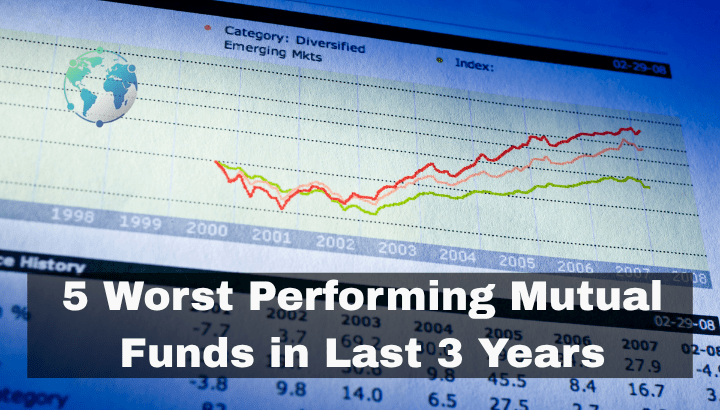Mutual funds are a popular way to invest in India. They offer benefits like diversification, expert management, and a chance to grow your money over time. But not all mutual funds do well. Some funds give low returns again and again because of poor stock selection, high expenses, or bad market conditions.
In this article, we will look at the 5 worst performing mutual funds in India over the last 3 years. This list is based on real data and will help you make better investment choices. Avoiding poor-performing funds is just as important as picking the best ones.
Why Do Some Mutual Funds Perform Poorly?
Before jumping into the 5 worst performing mutual funds in the last 3 years, let’s first understand why some mutual funds don’t give good returns:
- Poor Fund Management – If the fund manager makes bad investment decisions, the mutual fund may not perform well.
- High Expense Ratios – If the fund charges high fees, your actual returns will be lower.
- Wrong Sector Exposure – If the fund invests in sectors that are not doing well over the period, then it can hurt your overall performance.
- Market Volatility – If the fund is too exposed to markets that go up and down a lot, it may lose more during tough times.
- Lack of Diversification – If the fund invests in too few stocks or sectors, it becomes riskier and more affected by market changes.
If a fund can’t beat its benchmark or give steady returns over time, then it is better to stay away from it, because it can put you in greater loss over time.
5 Worst Performing Mutual Funds in the Last 3 Years
1. LIC MF Infrastructure Fund – Regular Plan (G)
- As of 2024, this fund gave around 2.1% return per year over the last 3 years.
- It is compared with the Nifty Infrastructure TRI benchmark, which tracks top infrastructure companies.
- The fund charges a 2.57% expense ratio yearly from your investment as management fees.
What Went Wrong?
This fund did not perform well because it mainly picked the wrong stocks in the infrastructure sector, which itself was not doing well. Also, the high expense ratio reduced the returns even more. It did worse than other similar funds and its benchmark.
Investor Tip
Avoid sector-focused funds unless you understand the sector really well. These funds can be risky and are not suitable for beginners or conservative investors.
2. Sahara Tax Gain Fund – Regular Plan (G)
- As of 2024, this fund gave around 2.5% return per year over the last 3 years.
- This fund falls under ELSS (Equity Linked Savings Scheme) benchmark and should be compared with other tax-saving mutual funds.
- The expense ratio of this fund has a high fee of 2.95% per year, which reduces your overall returns.
What Went Wrong?
This is one of the worst tax-saving mutual funds in India. Its stock selection was poor and there was not active management of the portfolio. While most ELSS funds gave over approx. 12% in 3 years, this one gave very low income.
Investors Tip
Always choose ELSS funds with a strong track record and consistent returns. Avoid funds with poor management and high costs, even if they offer tax benefits.
3. Quantum Multi Asset Fund of Funds – Direct Plan (G)
- As of 2024, this fund gave around 3.6% return per year over the last 3 years.
- This fund falls under the Fund of Fund (FoF) type of benchmark, which means it invests in other Quantum mutual funds.
- It charges 0.68% of expense ratio, but the real cost is higher because it includes the fees of the underlying funds too, which is a basic fund.
What Went Wrong?
This fund of funds (FoF) puts money in other Quantum funds. Both the equity and debt parts didn’t perform well. Even though its expense ratio seems low, the total cost is higher due to the FoF structure.
Investors Tip
Be careful with fund of funds (FoF) and make sure the funds they invest in are also doing well. Otherwise, your overall return may suffer despite a low direct expense ratio.
4. HSBC Infrastructure Fund – Regular Plan (G)
- This fund gave around 3.2% return per year in the last 3 years, as per 2024 data.
- It is benchmarked against the Nifty Infrastructure TRI, which tracks top infrastructure companies.
- The expense ratio of this fund has a high fee of 2.53% per year, which reduces your overall returns.
What Went Wrong?
Like other infrastructure sector funds. This one also didn’t do well in the market. It failed to choose the right stocks and didn’t adjust its strategy as per the market, which led to poor returns and disappointed investors looking for steady growth over time.
Investors Tip
Sectoral funds are very risky and often depend on market ups and down. Invest only if you have a high-risk appetite and know how that sector behaves in different economic conditions.
5. ICICI Prudential Regular Saving Fund – Regular Plan (G)
- This fund gave around 3.8% return per year in the last 3 years, as per 2024 data.
- It is a Hybrid-Conservative fund, which means it invests most in debt (bonds) and a small portion in equity (stock).
- The fund charges 2.04% of expense ratio per year for managing your investments.
What Went Wrong?
This hybrid fund has more debt than equity. Rising interest rates in recent years hurt its bong investment. Compared to other similar funds, it gave lower returns for the amount of risk taken, which means investors didn’t get enough reward for the risk they took.
Investors Tip
Always choose a mutual fund that matches your risk level, hybrid funds are not always low-risk, as some may invest more in stocks and carry higher risk than expected.
How to Identify Poor-Performing Mutual Funds
Here are some common signs to identify the poor performing mutual funds, that might not be a good investment option:
- Consistent Underperformance: If the fund keeps giving lower returns than its benchmark for more than 3 years, it may not be an ideal choice to invest your money.
- High Expense Ratio: A fund with an expense ratio above 2.5% can reduce your returns over time. High fees are usually a red flag.
- No Portfolio Updates: If the fund rarely updates its top holdings or doesn’t adjust with market changes, it might not be actively managed well.
- Low AUM (Asset Under Management): A fund with low AUM means fewer investors trust it. This can also affect liquidity and fund performance.
- Poor Fund Manager Track Record: It’s important to check who manages the fund. If the fund manager has a weak or inconsistent history, that’s a concern and it can lead you to loss.
Always do your own research and compare multiple funds before investing to avoid poor-performing mutual funds.
What Should You Do as an Investor?
If you are invested in one of the above underperforming mutual funds, here are a few important steps to take:
- Evaluate Your Goals: Think about your financial needs and goals. Is the fund still helping you work towards your long-term goals, like retirement or buying a house?
- Compare With Peers: Check how your mutual fund is performing compared to other similar funds in the same category. This will show if the issue is with the market or just your fund.
- Exit and Switch: If the mutual fund has underperformed regularly for 2-3 years, it may be wise to exit and switch to a more reliable or better performing fund.
- Seek Professional Advice: Before making any major changes, consult a SEBI-registered advisor who can guide you based on your risk level and investment plan.
Conclusion
Mutual fund investments are not just about choosing the best performing funds, but also about avoiding the worst ones. By regularly reviewing, tracking performance, and doing some research, you can stay away from bad mutual funds.
Every fund may face ups and downs in the short term, but if it keeps underperforming for 3 years, it’s a warning sign. Protect your hard-earned money by staying informed and making smart investment choices.
FAQs
Is it safe to invest in mutual funds with past poor performance?
Not always. Some mutual funds with poor past performance may bounce back, but if a fund keeps doing badly for a long time, it could mean something is wrong.
Can I lose all my money in a mutual fund?
Mutual funds spread your money across many stocks and bonds, which lowers the risk. But you can still face capital loss, especially in sectoral or thematic funds.
Should I stop SIP if my mutual fund is underperforming?
Yes, if the mutual fund is underperforming for 2-3 years in a row. You can stop your SIP and move it to a better performing fund in the same category.
How often should I review my mutual funds portfolio?
Review your mutual fund portfolio at least once in 6 months. Check how the fund is performing compared to its benchmark and the category average.
What is the role of expense ratio in fund performance?
A high expense ratio reduces your returns. Always look at the fund’s net return after fees and compare them with other similar funds before investing.

